Page 151 of 417
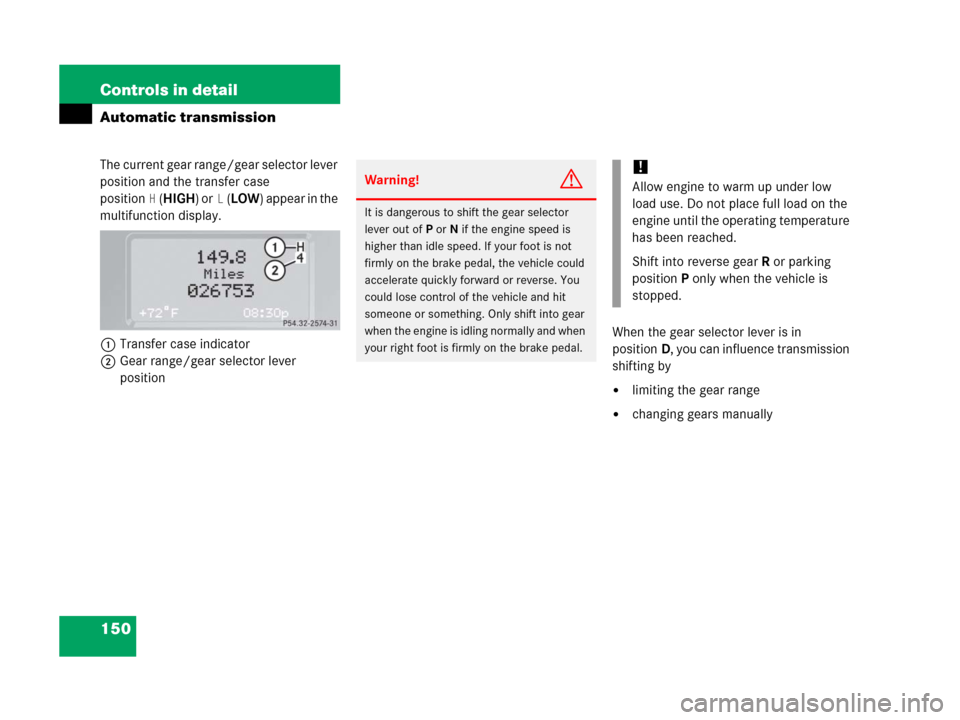
150 Controls in detail
Automatic transmission
The current gear range/gear selector lever
position and the transfer case
position
H(HIGH) orL(LOW) appear in the
multifunction display.
1Transfer case indicator
2Gear range/gear selector lever
positionWhen the gear selector lever is in
positionD, you can influence transmission
shifting by
�limiting the gear range
�changing gears manually
Warning!G
It is dangerous to shift the gear selector
lever out ofP orN if the engine speed is
higher than idle speed. If your foot is not
firmly on the brake pedal, the vehicle could
accelerate quickly forward or reverse. You
could lose control of the vehicle and hit
someone or something. Only shift into gear
when the engine is idling normally and when
your right foot is firmly on the brake pedal.
!
Allow engine to warm up under low
load use. Do not place full load on the
engine until the operating temperature
has been reached.
Shift into reverse gearR or parking
positionP only when the vehicle is
stopped.
Page 152 of 417
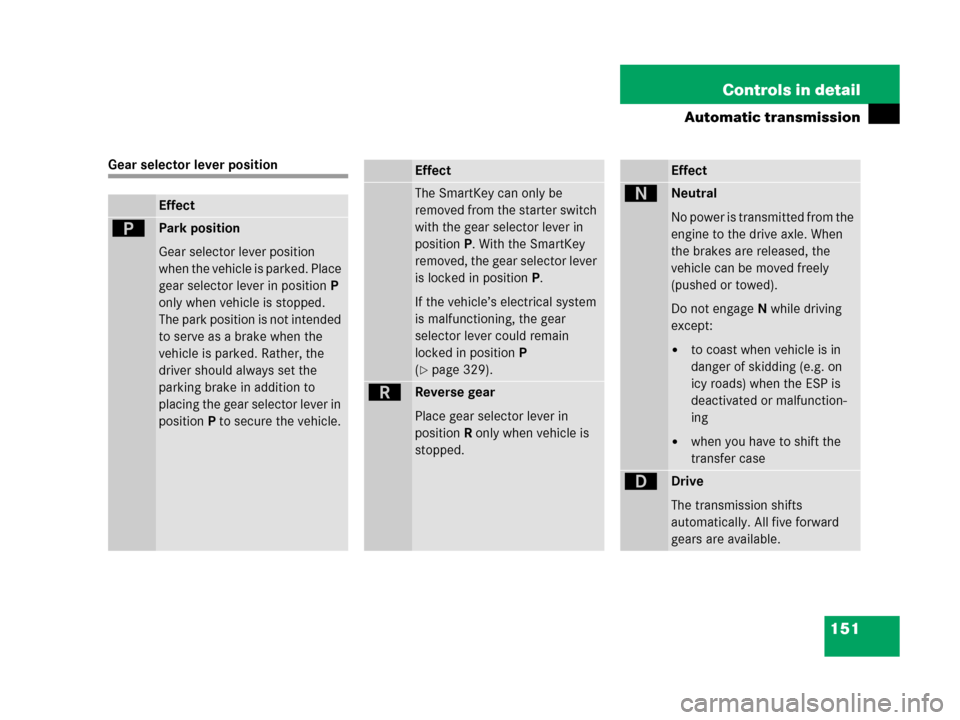
151 Controls in detail
Automatic transmission
Gear selector lever position
Effect
ìPark position
Gear selector lever position
when the vehicle is parked. Place
gear selector lever in positionP
only when vehicle is stopped.
The park position is not intended
to serve as a brake when the
vehicle is parked. Rather, the
driver should always set the
parking brake in addition to
placing the gear selector lever in
positionP to secure the vehicle.
Effect
The SmartKey can only be
removed from the starter switch
with the gear selector lever in
positionP. With the SmartKey
removed, the gear selector lever
is locked in positionP.
If the vehicle’s electrical system
is malfunctioning, the gear
selector lever could remain
locked in positionP
(
�page 329).
íReverse gear
Place gear selector lever in
positionR only when vehicle is
stopped.
Effect
ëNeutral
No power is transmitted from the
engine to the drive axle. When
the brakes are released, the
vehicle can be moved freely
(pushed or towed).
Do not engageN while driving
except:
�to coast when vehicle is in
danger of skidding (e.g. on
icy roads) when the ESP is
deactivated or malfunction-
ing
�when you have to shift the
transfer case
êDrive
The transmission shifts
automatically. All five forward
gears are available.
Page 153 of 417
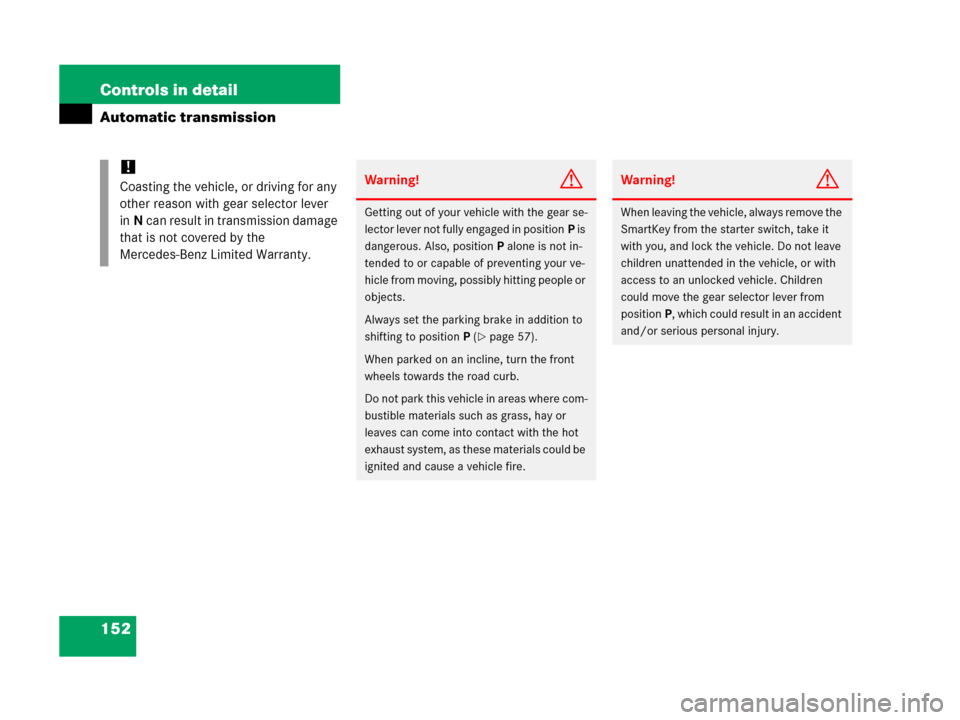
152 Controls in detail
Automatic transmission
!
Coasting the vehicle, or driving for any
other reason with gear selector lever
inN can result in transmission damage
that is not covered by the
Mercedes-Benz Limited Warranty.Warning!G
Getting out of your vehicle with the gear se-
lector lever not fully engaged in positionP is
dangerous. Also, positionP alone is not in-
tended to or capable of preventing your ve-
hicle from moving, possibly hitting people or
objects.
Always set the parking brake in addition to
shifting to positionP (
�page 57).
When parked on an incline, turn the front
wheels towards the road curb.
Do not park this vehicle in areas where com-
bustible materials such as grass, hay or
leaves can come into contact with the hot
exhaust system, as these materials could be
ignited and cause a vehicle fire.
Warning!G
When leaving the vehicle, always remove the
SmartKey from the starter switch, take it
with you, and lock the vehicle. Do not leave
children unattended in the vehicle, or with
access to an unlocked vehicle. Children
could move the gear selector lever from
positionP, which could result in an accident
and/or serious personal injury.
Page 154 of 417
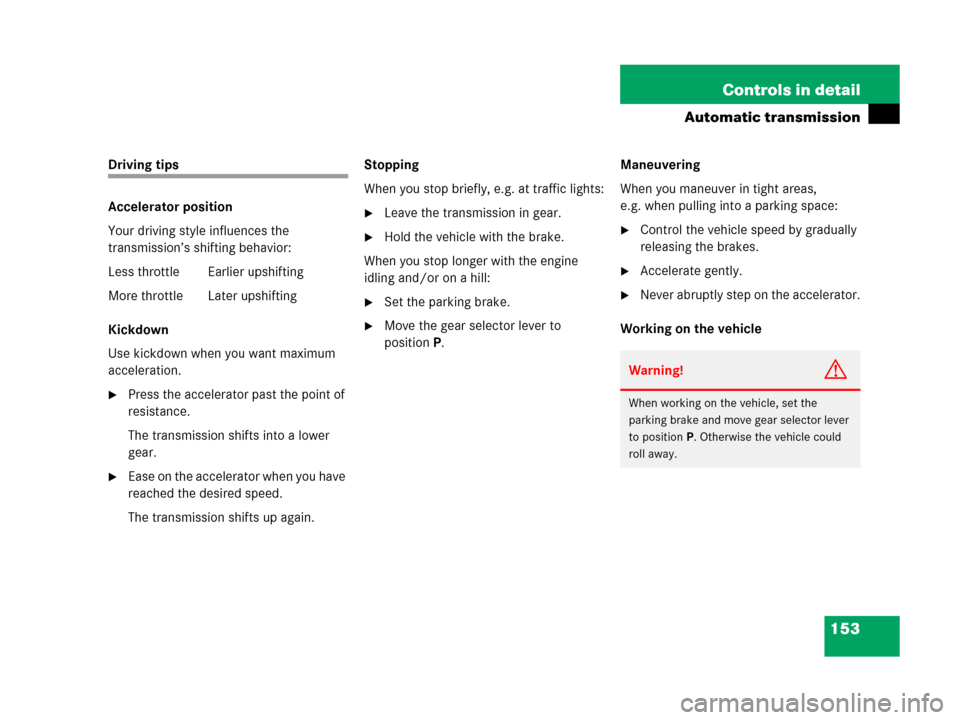
153 Controls in detail
Automatic transmission
Driving tips
Accelerator position
Your driving style influences the
transmission’s shifting behavior:
Less throttle Earlier upshifting
More throttle Later upshifting
Kickdown
Use kickdown when you want maximum
acceleration.
�Press the accelerator past the point of
resistance.
The transmission shifts into a lower
gear.
�Ease on the accelerator when you have
reached the desired speed.
The transmission shifts up again.Stopping
When you stop briefly, e.g. at traffic lights:
�Leave the transmission in gear.
�Hold the vehicle with the brake.
When you stop longer with the engine
idling and/or on a hill:
�Set the parking brake.
�Move the gear selector lever to
positionP.Maneuvering
When you maneuver in tight areas,
e.g. when pulling into a parking space:
�Control the vehicle speed by gradually
releasing the brakes.
�Accelerate gently.
�Never abruptly step on the accelerator.
Working on the vehicle
Warning!G
When working on the vehicle, set the
parking brake and move gear selector lever
to positionP. Otherwise the vehicle could
roll away.
Page 159 of 417
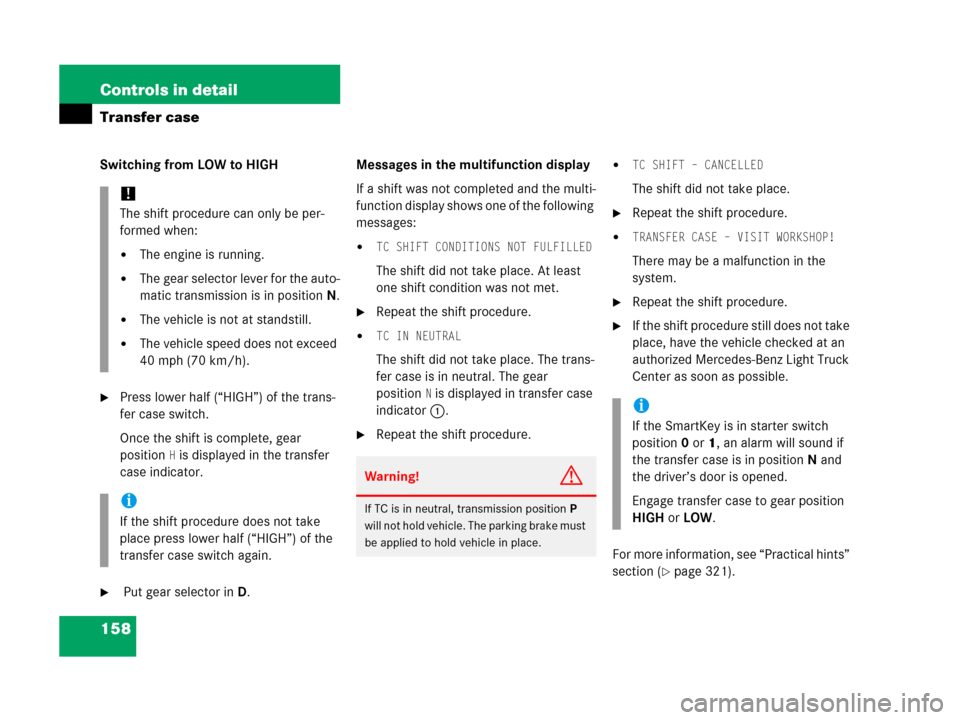
158 Controls in detail
Transfer case
Switching from LOW to HIGH
�Press lower half (“HIGH”) of the trans-
fer case switch.
Once the shift is complete, gear
position
H is displayed in the transfer
case indicator.
� Put gear selector in D.Messages in the multifunction display
If a shift was not completed and the multi-
function display shows one of the following
messages:
�TC SHIFT CONDITIONS NOT FULFILLED
The shift did not take place. At least
one shift condition was not met.
�Repeat the shift procedure.
�TC IN NEUTRAL
The shift did not take place. The trans-
fer case is in neutral. The gear
position
N is displayed in transfer case
indicator1.
�Repeat the shift procedure.
�TC SHIFT – CANCELLED
The shift did not take place.
�Repeat the shift procedure.
�TRANSFER CASE – VISIT WORKSHOP!
There may be a malfunction in the
system.
�Repeat the shift procedure.
�If the shift procedure still does not take
place, have the vehicle checked at an
authorized Mercedes-Benz Light Truck
Center as soon as possible.
For more information, see “Practical hints”
section (
�page 321).
!
The shift procedure can only be per-
formed when:
�The engine is running.
�The gear selector lever for the auto-
matic transmission is in positionN.
�The vehicle is not at standstill.
�The vehicle speed does not exceed
40 mph (70 km/h).
i
If the shift procedure does not take
place press lower half (“HIGH”) of the
transfer case switch again.
Warning!G
If TC is in neutral, transmission positionP
will not hold vehicle. The parking brake must
be applied to hold vehicle in place.
i
If the SmartKey is in starter switch
position0 or1, an alarm will sound if
the transfer case is in positionN and
the driver’s door is opened.
Engage transfer case to gear position
HIGH or LOW.
Page 182 of 417
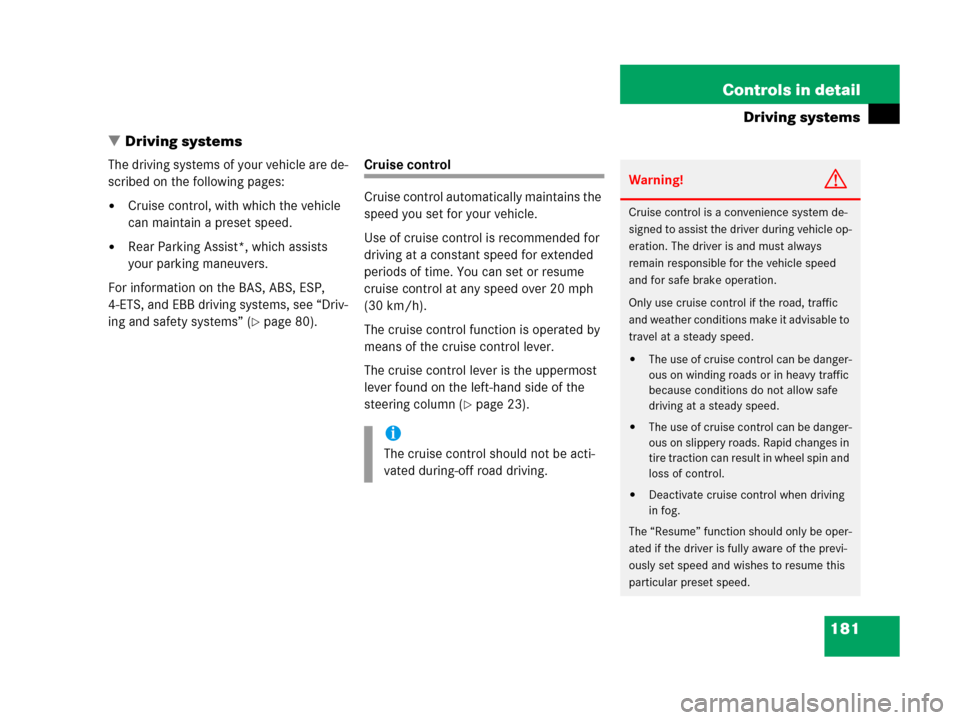
181 Controls in detail
Driving systems
�Driving systems
The driving systems of your vehicle are de-
scribed on the following pages:
�Cruise control, with which the vehicle
can maintain a preset speed.
�Rear Parking Assist*, which assists
your parking maneuvers.
For information on the BAS, ABS, ESP,
4-ETS, and EBB driving systems, see “Driv-
ing and safety systems” (
�page 80).
Cruise control
Cruise control automatically maintains the
speed you set for your vehicle.
Use of cruise control is recommended for
driving at a constant speed for extended
periods of time. You can set or resume
cruise control at any speed over 20 mph
(30 km/h).
The cruise control function is operated by
means of the cruise control lever.
The cruise control lever is the uppermost
lever found on the left-hand side of the
steering column (
�page 23).
i
The cruise control should not be acti-
vated during-off road driving.
Warning!G
Cruise control is a convenience system de-
signed to assist the driver during vehicle op-
eration. The driver is and must always
remain responsible for the vehicle speed
and for safe brake operation.
Only use cruise control if the road, traffic
and weather conditions make it advisable to
travel at a steady speed.
�The use of cruise control can be danger-
ous on winding roads or in heavy traffic
because conditions do not allow safe
driving at a steady speed.
�The use of cruise control can be danger-
ous on slippery roads. Rapid changes in
tire traction can result in wheel spin and
loss of control.
�Deactivate cruise control when driving
in fog.
The “Resume” function should only be oper-
ated if the driver is fully aware of the previ-
ously set speed and wishes to resume this
particular preset speed.
Page 185 of 417

184 Controls in detail
Driving systems
Rear Parking Assist*
The Rear Parking Assist system is an elec-
tronic aid designed to assist the driver dur-
ing parking maneuvers. It visually and
audibly indicates the relative distance be-
tween the rear of the vehicle and an obsta-
cle.
The Rear Parking Assist system is auto-
matically activated when you switch on the
ignition and shift the gear selector lever to
positionR.The Rear Parking Assist system monitors
the rear area of your vehicle by means of
four sensors in the rear bumper.
1Sensors
Warning!G
Rear Parking Assist (rear Parktronic) is a
supplemental system. It is not intended to,
nor does it replace, the need for extreme
care. The responsibility during parking and
other critical maneuvers always rests with
the driver.
Special attention must be paid to objects
with smooth surfaces or low silhouettes
(e.g. trailer couplings, painted posts, or
street curbs). Such objects may not be de-
tected by the system and can damage the
vehicle.
The operational function of the Rear Parking
Assist can be affected by dirty sensors, es-
pecially at times of snow and ice. See
“Cleaning the Rear Parking Assist sensors”
(
�page 286).
Interference caused by other ultrasonic sig-
nals (e.g. working jackhammers or the air
brakes of trucks) can cause the system to
send erratic indications, and should be tak-
en into consideration.
Warning!G
Make sure no persons or animals are in the
area in which you are maneuvering. You
could otherwise injure them.
Page 186 of 417

185 Controls in detail
Driving systems
Range of the sensors
To function properly, the sensors must be
free of dirt, ice, snow, and slush. Clean the
sensors regularly, being careful not to
scratch or damage them.Minimum distance
The minimum distance between the sen-
sors and an obstacle is approximately
20 in (50 cm). If you encounter an obstacle
in this range, all the warning lamps come
on and you hear a warning signal. If the ob-
stacle is closer than the minimum dis-
tance, the actual distance may no longer
be indicated by the system. Centerapprox. 59.1 in (150 cm)
Cornersapprox. 40 in (100 cm)
!
During parking maneuvers, pay special
attention to objects located above or
below the height of the sensors (e.g.
planters or trailer hitches). The Rear
Parking Assist system will not detect
such objects at close range and dam-
age to your vehicle or the object may
result.
Ultrasonic signals from outside sourc-
es (e.g. truck air brakes or jackham-
mers) may impair the operation of the
Rear Parking Assist system.